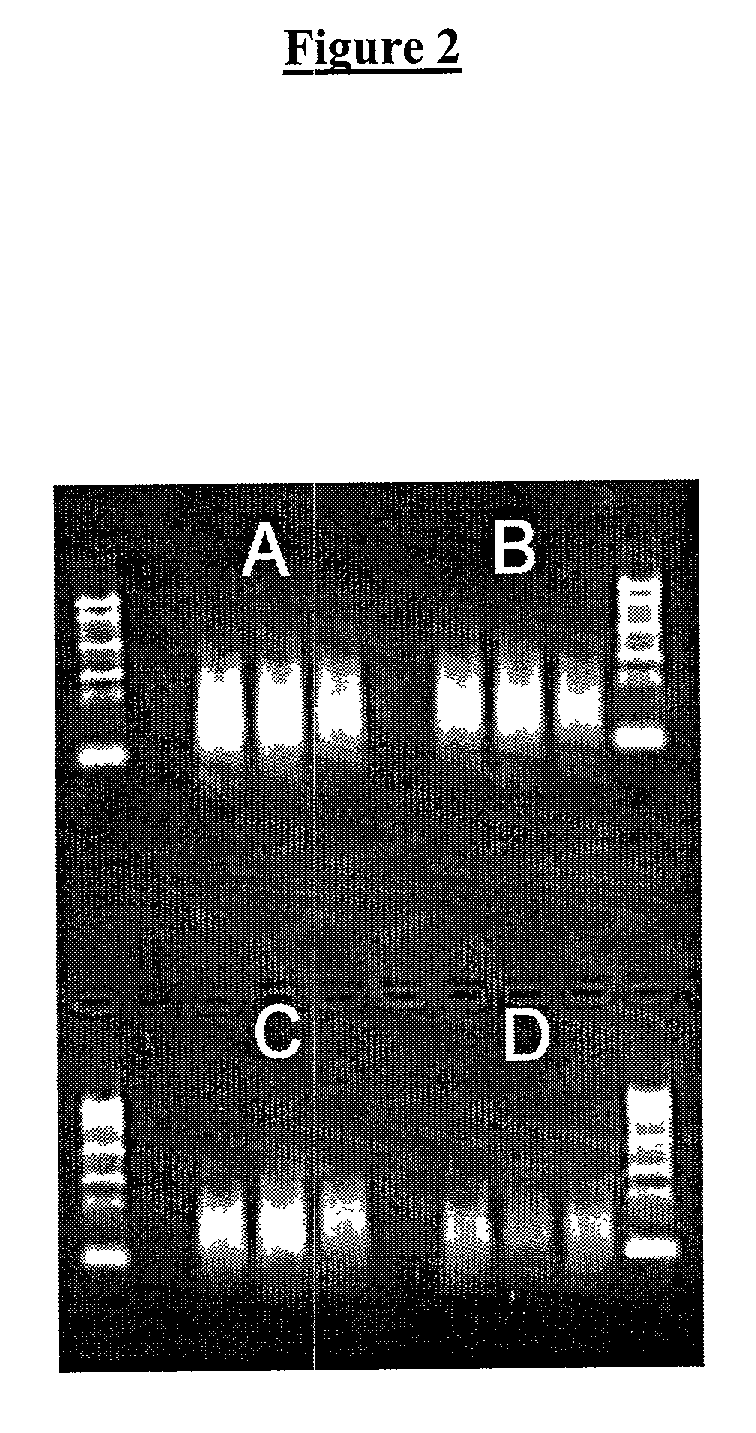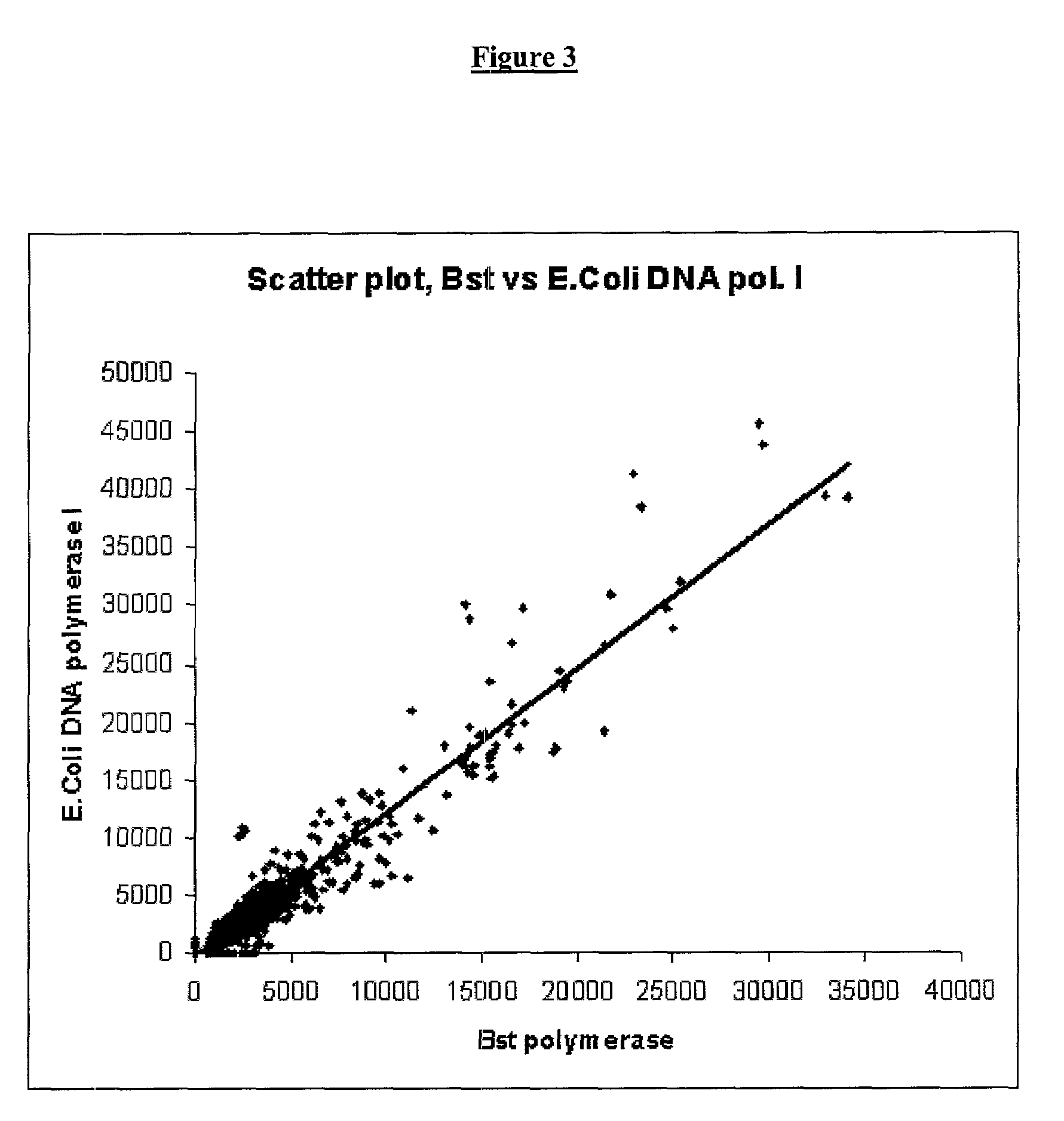Method for generating amplified RNA
a technology of amplified rna and amplified rna, which is applied in the field of amplified rna generation, can solve the problems of inability to obtain this number of cells from the tissue of interest, inability to achieve the effect of reducing the time period, high efficiency, and small amoun
- Summary
- Abstract
- Description
- Claims
- Application Information
AI Technical Summary
Benefits of technology
Problems solved by technology
Method used
Image
Examples
example 1
2nd Strand cDNA Synthesis Starting from Total RNA
[0083]For second strand cDNA synthesis, we used the Gubler-Hoffman method as a reference point. This is a very well established method for synthesizing the second cDNA strand that uses a mix of E.Coli DNA polymerase I, Rnase H and DNA ligase I. It generates RNA oligomers from the mRNA strand in the mRNA-cDNA hybrid produced from the first strand cDNA synthesis, and uses these as primers for the second strand synthesis. We titrated temperature and time of incubation using E. Coli DNA polymerase I and Bst polymerase.
First Strand cDNA Synthesis
[0084]100 ng of total rat brain RNA was mixed with 500 ng of T7dT21 primer (5′-TCTAGTACCTGCTTCACTGCATCTAATACGACTCACTATAGGGAGATTTTTTTTTTTTT TTTTTTTT-3′) (SEQ ID NO: 1) in a total volume of 11 μl. The mix was denatured at 70° C. for ten minutes and put on ice. cDNA was synthesized using 200 units SuperScript II reverse transcriptase (Invitrogen) in 50 mM Tris-HCl, 75 mM KCl, 3 mM MgCl2, 20 mM dithiot...
example 2
Second Strand cDNA Synthesis from aRNA
[0101]The aRNA produced by T7 RNA amplification can be used as the input RNA for an additional round of T7 RNA amplification. The aRNA produced in the first round is in the antisense orientation and thus lacks any known sequence in the 3′-end. The cDNA synthesis from aRNA is therefore primed using random hexamers. To regenerate the T7 RNA polymerase promoter site, the aRNA-cDNA hybrid is then denatured and second strand cDNA synthesis is primed using the T7dT21 primer. This is a different way of synthesizing second strand cDNA to the first round of T7 RNA amplification where second strand cDNA synthesis is primed by RNA oligomers left by the RNase H activity. Therefore we set out to identify the optimal conditions for synthesizing second strand cDNA in the second round of T7 RNA amplification. First the temperature and time requirements were titrated using E. Coli DNA polymerase I. Then a similar set of experiments was done using Bst polymerase....
example 3
Microarray Probe Synthesis
[0129]Cy3 labeled cDNA probes were synthesized from aRNA. In brief, 10 μg aRNA and 5 μg random hexamers were mixed in a total volume of 26 μl (containing RNase free H2O), heated to 70° C. for 10 minutes and chilled on ice. Then, 10 μl first strand buffer, 5 μl 0.1MDTT, 1.5 μl RNasin. 1 μl 25 mM d(GAT)TP, 2 μl 1 mM dCTP, 2 μl 1 mM Cy3-dCTP (Amersham) and 2.5 μl Superscript RT II were added and incubated at room temperature for ten minutes and then 37° C. for two hours. To degrade the aRNA template, the sample was digested using 10 units of RNase H (Invitrogen) and 0.1 units of RNase A (Sigma) for ten minutes at 37° C. The samples were purified on PCRquick columns (Qiagen). The probes were vacuum dried and re-suspended in 50% formamide, 5× microarray hybridization buffer (Amersham Biosciences) in a total volume of 50 ml. The probe was denatured at 95° C. for ten minutes and then cooled on ice.
Microarray Hybridization and Washes
[0130]The hybridization probe wa...
PUM
| Property | Measurement | Unit |
|---|---|---|
| temperature | aaaaa | aaaaa |
| temperature | aaaaa | aaaaa |
| temperature | aaaaa | aaaaa |
Abstract
Description
Claims
Application Information
 Login to View More
Login to View More - R&D
- Intellectual Property
- Life Sciences
- Materials
- Tech Scout
- Unparalleled Data Quality
- Higher Quality Content
- 60% Fewer Hallucinations
Browse by: Latest US Patents, China's latest patents, Technical Efficacy Thesaurus, Application Domain, Technology Topic, Popular Technical Reports.
© 2025 PatSnap. All rights reserved.Legal|Privacy policy|Modern Slavery Act Transparency Statement|Sitemap|About US| Contact US: help@patsnap.com



